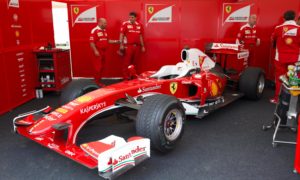In 2006, the FIA introduced a new rule that the 3 litre V10 engines were out and the 2.4 litre V8 engines were in.
Formula 1 has become a much safer sport. Cars now sport a variety of safety features which allows modern racing drivers to walk away from horrific crashes which they would not have survived years earlier. The last time a driver died on the track was 1994.
Despite this, the FIA still believe that more can be done to increase the safety margins and help protect the drivers further. However this sometimes compromises the whole essence of Formula 1. Formula 1 is meant to be the pinnacle of racing, mixing speed with cutting-edge technology.
The first reason that the FIA introduced this rule was in the hope that the cars would be slower and hence safer. Early on, teams predicted losing as much as 2.5 seconds a lap with the new engines on-board. It also meant radical changes to the cars’ design to ensure they were getting the best performance possible. Gone was the tactic of putting down as much power as possible out of the corner; In was trying to carry as much speed as possible through the corner to dissipate the effects of the differences in torque between the V10 and the V8 engines.
This is not the first time that the FIA have imposed engine restrictions. Before 2000, engine configurations were largely left up to the teams. Engine capacity was always limited, but the number of cylinders was always a team choice. Honda were at one stage considering a V12 engine as it would have provided a lower centre of gravity and more revs. In the end, they stuck with the V10 saying these positives were outweighed by the poor torque characteristics and engine lengths. In 2000, the FIA announced that all teams had to use a V10 engine. Toyota had unfortunately been developing a new V12 engine and lost out with this announcement. They had to pay a £6 million penalty and create a whole new engine in just one season.
Downsizing engine configuration and capacity will obviously leave the car with less BHP and this will affect the maximum speed of the car, as well as the torque patterns and acceleration.
As it turns out, the teams’ predictions of losing about 2.5 seconds a lap were nearly spot on. In previous years, Formula 1 cars would be about one and a half seconds per lap faster than the year before through technological advances. . Between the 2005 and 2006 season, Formula 1 cars were just over a second down on lap times from the previous year. This shows that the estimate of 2.5 seconds loss was a pretty good guess.
Of course, this varies from track to track and in some cases such as Monaco, the cars were actually going faster. Monaco is seen as one of the most dangerous tracks – the track is narrow and there aren’t many run off areas. So this looks like it contradicts the FIA’s objective of creating a safer sport. Why were the cars at Monaco quicker this season? Because the cornering speeds were higher and there are a lot of tight corners at Monaco! Again, this contradicts the FIA’s main objective. Corners are generally more dangerous than straights because it’s where the majority of overtakes take place and if something is wrong with the car – maybe a flat tyre or part of the car is damaged – it is more likely that the car will go out of control and crash.
The second objective of the introduction rul change was to save money. Short term this has not worked. All the teams have had to spend money designing and developing a new engine, and then redesign their car around the engine performance. Long term, it will probably be cheaper as the V8 engines are cheaper to produce, however it may be a long while before the teams see the full positive monetary effects that this rule change was meant to usher in.
Overall, did the rule change work? The safety aspect: Yes, they slowed the cars down however they did not slow them down where in mattered the most – the corners. The money perspective: Costs may be down long term, but it’s impossible to say how much the change has affected the teams. The new engine homologation rule and the engine concessions will affect the engine costs far more than the introduction of the V8 engine did. The new rule also stifles the very soul of Formula 1 – innovation, particularly when they also ban innovations such as mass dampers and new style wings. Overall, I do not believe that the rule change was successful.








